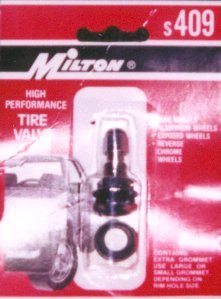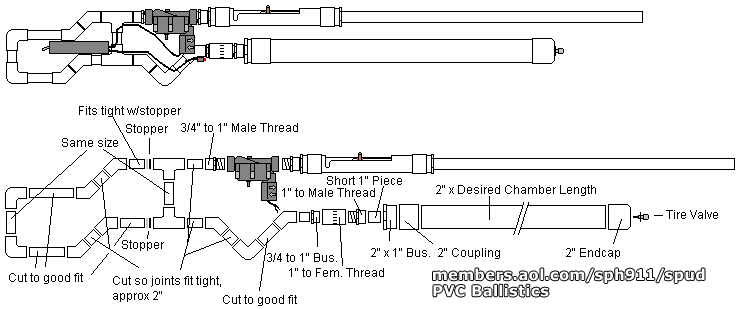Spudgun Valves
Air cannons use valves as a means of both getting air into the gun, and getting it out, launching a potato with great hilarity.
Charging Valve
 A standard "Shcraeder" air pump valve is used to charge a pneumatic cannon. These valves are most often found on car tires and bike tires. A simple replacement valve for a car tire will suffice. Simply drilla hole in an endcap and thread the valve in place, sealing with sealant or teflon tape.
A standard "Shcraeder" air pump valve is used to charge a pneumatic cannon. These valves are most often found on car tires and bike tires. A simple replacement valve for a car tire will suffice. Simply drilla hole in an endcap and thread the valve in place, sealing with sealant or teflon tape.
Manual
Ball Valve
Made out of either plastic or metal, ball valves are considered inferior by many enthusiasts due to their slow opening times. For those on a tight budget or in low-power setups, ball valves are ideal. Some choose to modify their valves by attaching a pneumatic actuator or spring to achieve a faster opening speed.
Blowgun
A blowgun is a small hand held device used to blow away debris from a work area and is designed to be used attached to a compressed air line. It uses a sprung poppet valve operated by a lever to allow air through its body and out through a specially shaped nozzle. In spudgunning it is used to pilot larger valves - releasing a small volume of air to allow a piston or diaphragm to fly back and release a much larger volume of air into the barrel. It is also used as the primary valve for small cannons which fire airsoft pellets and so do not require high air flow. Blowguns can be modified to increase airflow.
Electronic
Sprinkler valve
Otherwise known as a Solenoid valve. The use of irrigation sprinkler valves as pneumatic valves has become increasingly popular for spudgunning. These valves are intended to be electronically triggered causing a solenoid to depressurise a diaphragm and allow airflow through. It is also possible to remove the solenoid and, instead, to actuate the valve manually with a blowgun to depressurise the diaphragm. Such modifications allow the valve to open as much as 3 to 5 times faster.
Pneumatic
Diaphragm valve
A diaphragm valve is used in pneumatic cannons where the barrel is within the air chamber. It is a disk of flexible material mounted directly behind the barrel that seals it when pressure is increased behind the disk. The design is such that air leaks past the diaphragm from behind it to the chamber around the barrel, sealing the soft rubber against the butt of the barrel. Once the chamber is fully pressurised the compressed air behind the diaphragm is quickly vented, causing the centre of the diaphragm to flex backwards, exposing the butt of the barrel to the compressed air inside the chamber, which rapidly exhausts through the barrel, launching the projectile.
Piston valve
The gold standard of pneumatic spudgunning is the piston valve, due to its extremely high rate of flow and opening speed. It works in an almost identical fashion to a diaphragm valve but replaces the flexible diaphragm with a hard rubber-faced piston. The valve opening is generally as wide as or wider than the barrel diameter, so there is very little constriction of airflow. Piston valves also open much faster than either ball or solenoid valves. However, construction of this type of valve is inherently complex, and some choose to order pre-built valves through the internet.
Quick Exhaust Valve (QEV)
a commercial piston or diaphragm valve in a metal body intended for the quick venting of pneumatic cylinders. In spudgunning they are ideal barrel sealing valves with faster opening times than custom piston valves and high flow rates. They can be commonly found in sizes from 1/8" to 1.5" and sometimes even larger models. It provides an easy option for inexperienced spud-gun builders but the cost is usually greater than for any other valve type. (An exception to this is within the UK, where QEVs are relatively inexpensive.)
Burst Disk Valve
Used in a few pneumatics but primarily in hybrid cannons, burst valves are considered the ideal pressure release mechanism as they allow an unobstructed flow of high pressure air. Burst disks have no moving parts, making them very reliable. They are very appealing for hybrid cannons because they can withstand the low pressure gas mix in the chamber before ignition, yet fail as planned upon successful ignition. The high pressure combustion gases are released into the barrel at a rate which generates greater velocities than a mechanical valve could allow. Pneumatic cannon burst discs work similarly. The disc and projectile are loaded, and the chamber is pressurised until the disc ruptures. Unfortunately, this usually does not give the operators much in the way of control over timing, although a puncturing mechanism can be used. Burst disks are of no specific material and may consist of plastic or thin sheet metal or foil.


